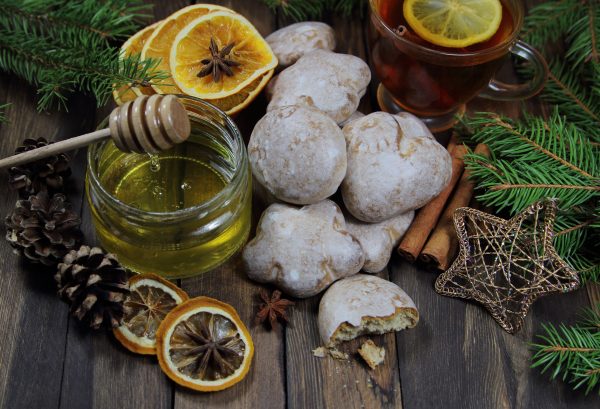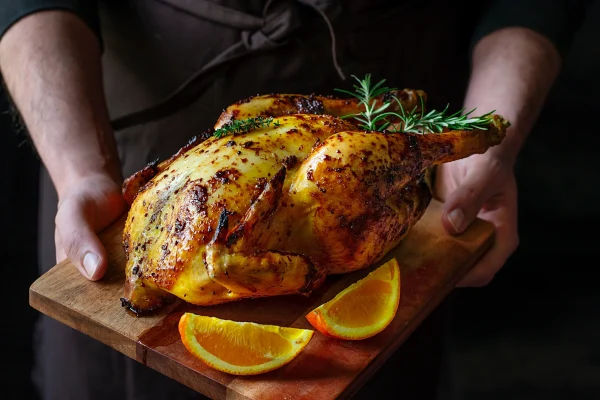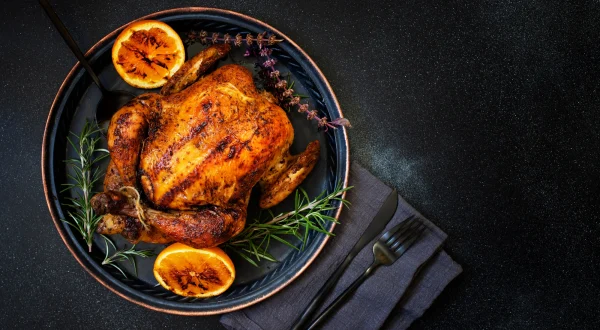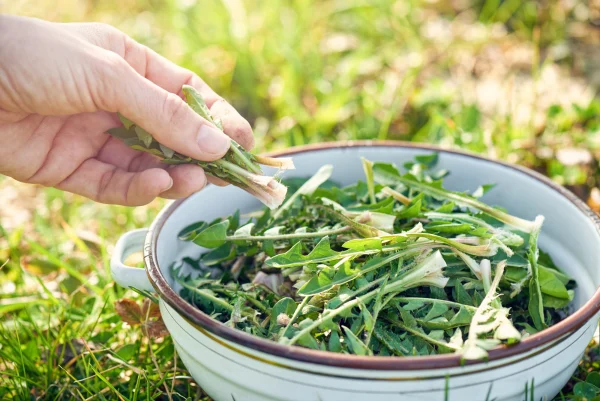
Anastassia’s Holiday Honey Pryanik Cookies
Inspired by Anastassia’s Russian roots, these soft honey cookies are easy to mix, fun to shape, and perfect for little helpers to decorate.








New York City is a city of hidden gems—remarkable spaces, architectural wonders, and transformative projects that shape how we live, work, and connect. Yet, so many of these places remain just out of reach for the average New Yorker. Open House New York (OHNY) has spent over two decades breaking down those barriers, giving the public rare behind-the-scenes access to the city’s most fascinating buildings, infrastructure, and public spaces.
Through year-round programs and the annual OHNY Weekend festival, the organization invites New Yorkers to explore, question, and better understand the spaces that define urban life. From historic landmarks to cutting-edge sustainable developments, OHNY highlights the power of thoughtful urban planning and design while advocating for a more open and accessible city for all.
But none of this work would be possible without the support of the community. That’s where the Open City Benefit, OHNY’s signature fundraising gala, comes in.
On Wednesday, April 30, 2025, from 6:00 PM to 9:00 PM, OHNY will host its annual Open City Benefit at Building 303 in the Brooklyn Navy Yard. This event is not just a fundraiser—it’s a celebration of OHNY’s mission and the incredible places and people shaping the future of New York City.
The evening will bring together hundreds of architects, urbanists, city leaders, and OHNY supporters for an immersive and inspiring experience. Set against the backdrop of the historic Brooklyn Navy Yard—an innovation hub that has transformed from a storied shipbuilding site into a center for technology, manufacturing, and sustainability—the event promises an unforgettable exploration of the past, present, and future of urban space.
Great Performances is proud to be catering this year’s Benefit, continuing a longstanding partnership with OHNY—we’ve had the privilege of catering many of their events over the years. As a longtime supporter of OHNY, we’re deeply aligned with their mission of opening up the city to all. Our founder, Liz Neumark, also serves on the OHNY board, and we’ve been thrilled to welcome New Yorkers into our own space during OHNY Weekend for behind-the-scenes tours of our kitchen and operations.
Guests will enjoy exclusive guided tours of Building 303, led by the project team behind its recent transformation, a seated dinner bringing together industry leaders and advocates of open access to the city, and the prestigious Open City Award presentation, honoring a groundbreaking project that has made a significant impact on New York’s urban landscape.
The Open City Benefit is OHNY’s largest source of funding, directly supporting its mission to keep New York’s built environment accessible and engaging for all. Proceeds from the event help fund OHNY Weekend, the organization’s flagship event that opens doors to hundreds of sites across the city each year, year-round programming including tours, discussions, and special events that connect people with the spaces shaping their daily lives, and advocacy initiatives working toward a city where architecture, infrastructure, and public spaces are truly open and inclusive.
For those passionate about the future of New York City, the Open City Benefit is an opportunity to celebrate, support, and engage with the movement for a more accessible urban landscape.
Tickets and sponsorship opportunities are available now. To learn more or reserve your spot, visit OHNY’s official website.
Join us for an evening of inspiration, conversation, and a shared vision of a more open New York City!
Planning a nonprofit gala or fundraiser can feel like a huge undertaking, but with the right approach, it becomes an exciting opportunity to create a meaningful experience for guests while supporting a great cause. We sat down with Ali Rea Baum, our Senior Event Director at Great Performances, to talk through some of the most common questions and challenges nonprofits face when organizing an event—and how to navigate them.
Planning a nonprofit gala starts with one key question: What kind of experience do you want your guests to have? That’s the foundation for everything else—venue, catering, entertainment, décor, and even sponsorship opportunities. Once you have that vision in place, you can start making decisions that support it.
Budget, hands down, is the biggest challenge for nonprofits when planning an event. The key is prioritizing. Every organization has to decide what matters most—is it the venue? The food? The entertainment? Once that’s clear, it’s easier to allocate funds where they’ll have the biggest impact.
Nonprofits should begin planning their galas and fundraising events at least a year out. That gives plenty of time to secure sponsorships, which can make a huge difference in offsetting costs. Sponsors also appreciate the advance notice so they can align the event with their own marketing plans and be sure to allocate their own budgets to supporting causes.
Choosing a venue goes beyond the basics like size and location; the venue should reflect the organization’s mission. If sustainability is a priority, choose a space with strong green initiatives. Accessibility is also key—guests should feel welcomed and comfortable.
Catering is one of our favorite ways to personalize an event! If the nonprofit focuses on food security, for example, we might create a menu that highlights local farms or zero-waste cooking. If the mission is about environmental conservation, a plant-based or sustainably sourced menu reinforces that message. The food should feel intentional and connected to the cause.
There are so many simple but effective ways to make an event more sustainable. Digital invitations instead of paper, compostable dinnerware, and reducing single-use plastics are easy wins. When it comes to catering, focusing on seasonal, locally sourced ingredients and donating leftovers to food rescue organizations can have a big impact.
Rental costs can be a surprise if they’re not factored in from the beginning. Things like additional staffing, security, or post-event cleaning can also sneak up on budgets. The best approach is to be upfront about potential costs early on and build in a little flexibility.
It’s hard to say what one area should nonprofits invest the most when planning a gala or fundraiser. It really depends on where it will make the biggest impact on the guest experience. That might mean high-quality catering, an engaging speaker, or immersive entertainment. If guests leave feeling inspired and connected to the cause, they’re more likely to donate.
Getting in-kind sponsorships is a game-changer in managing your budget for your gala or fundraiser. Donated wine, floral arrangements, or auction items can free up funds for other areas. Also, focusing on thoughtful details—like beautiful plating and great service—can make a big impression without requiring a huge spend.
Catering trends at galas and fundraisers vary widely, but lately we’re seeing a lot of demand for simplicity—seasonal menus, fewer but higher-quality choices, and interactive food stations. Family-style or plated dinners also work well because they create a sense of connection among guests.
Planning a nonprofit event is all about balance—staying true to the mission, creating an unforgettable guest experience, and making smart budget decisions. With thoughtful planning and the right partners, it’s possible to pull off a gala that’s both impactful and inspiring. If you’re ready to start planning your next event, Great Performances is here to help!
As the days get longer and the weather gets warmer, we get even more excited for the produce coming from our organic farm, Katchkie Farm, in the Hudson Valley. Over the years, our culinary team has worked even more closely with Farmer Jon to get ready for the the growing season, and we’ve all–from our chefs to our guests–enjoyed the bounty. Last year during the growing season, about 30% of the produce we use in our kitchens came from our own organic farm. We also share our bounty through our CSA program. Learn more about our CSA and sign up at Katchkie Farm’s website.
Spring is a very exciting time here on the farm. It is a time when the sunlight starts noticeably coming back, when we get glimpses of the warmer weather ahead, and when the plans that were dreamed of back in the depths of winter can begin in earnest.
No matter how many times I have seen it, watching the first seedlings sprout out of the soil, making their connection with the sunlight, brings me great joy. In the beginning of March, the first onion seeds made their way into soil-filled trays in our greenhouse and within a week, those same seeds started their emergence from the soil. For me this is the first true sign that the growing season has begun. We are now, several weeks into our nursery starts and the greenhouse is slowly filling up with lovely shades of green and leaves of various shapes and sizes. As the weather begins to settle, these young plants will make their way out into the fields and eventually onto the plates of our beloved customers.
This winter—and now merging into the spring months—has been loaded with tractor repairs. Usually there are a few weeks in leading up to growing season that I can set aside to get all the general maintenance on our machines finished, but this year there were some more involved repairs. At one point our workhorse tractor barely resembled a tractor. It was split into two pieces; the wheels, seat, and fuel tank were removed; and the transmission was in a box on the workshop table! After many trips to our local tractor dealer, late nights, and the help from a long-time mechanic friend, it was all put back together and is now ready for our spring field work.
One of the most exciting aspects of the upcoming season is getting to implement what I have learned over the winter months. Pouring over books and webinars about how plants cycle different nutrients, which minerals are essential at different points in a plant’s life cycle, as well as how to build soil carbon while growing a vegetable crop were some of the topics I had focused on. Some of these principles can be put into practice and will dovetail nicely with what we are already doing at Katchkie Farm. Others will have to be tried in much smaller trials. From what I can garner, the results will be quite delicious!
Ready to sign up for our CSA? Click the link below!
As we navigate a world where hybrid and remote work continue to shape corporate culture, companies are seeking fresh, innovative ways to bring their teams together and create memorable experiences. We reached out to our event partner, Coco Events, and Megan Josey shared some key trends shaping the landscape of corporate and nonprofit gatherings in 2025.
Corporate teams are looking to reconnect and engage outside of the traditional office space, with outdoor experiences at the top of their wish lists. Nostalgia is playing a significant role in event planning, with game show-style competitions like Family Feud—featuring custom company-specific questions—seeing a surge in popularity. Companies are also gravitating toward carnival themes and James Bond-inspired casino nights. Competitive activities such as pickleball tournaments, axe throwing, Gladiator challenges, and Bubble Soccer are fostering collaboration, competition, and camaraderie among employees. These high-energy, interactive experiences create lasting connections and boost morale in ways that traditional meetings simply can’t.
AI remains a buzzword in the corporate world, and event planners are integrating it in exciting ways. AI-powered photobooths, sketchbots, and VR experiences are captivating attendees, making for highly engaging activations. These tech-driven elements not only entertain but also demonstrate how innovation can be seamlessly woven into event experiences. Whether it’s a fully immersive virtual reality station or AI-generated artwork, technology is elevating engagement at corporate gatherings.
Companies are embracing the art of customization, tailoring every aspect of their events to align with their brand identity and goals. From branded prize crane games for product launches to custom-built locker room experiences for spirits tastings, personalized activations are in high demand. Unique elements like 3D-printed candy, interactive murals, and Lite Brite brand logo displays are turning standard corporate events into unforgettable brand showcases.
Creating shareable moments is more important than ever. Custom photobooths featuring company branding are helping organizations make a lasting impression, whether at internal team-building events or consumer-facing activations. Employees and guests love capturing and sharing their experiences, making these moments not just interactive but also powerful marketing tools.
Coco Events continues to be a leader in bringing these creative visions to life. If you’re looking for ways to enhance engagement at your next corporate or nonprofit event, reach out to Megan Josey at Coco Events. She and her team can help craft an experience that your attendees will be talking about long after the event ends.
Want to see some of these activations in action? Let us know, and we’d be happy to share images and examples to inspire your next gathering.
Here’s to making every event an experience to remember!
At Great Performances, food is woven into every moment from a quick coffee break to a grand celebratory feast. We bring this belief to life through delicious food, warm hospitality, and boundless culinary creativity. At the heart of it all is our Chefs’ Choir℠ ensemble – a unique and diverse group of extraordinary chefs and cooks who power our catering, café, and restaurant services. With their diverse talents, perspectives, and culinary expertise, they shape the unforgettable menus that define our events, from corporate gatherings and nonprofit galas to weddings and milestone celebrations; and that feed our diners at our cafés and restaurants.
Through the Chefs’ Choir℠ ensemble, our chefs step beyond the kitchen to share their passion and expertise directly with you. They offer recipes to try at home, stories that inspire, insights into their craft, and tips to elevate your cooking. Whether you’re looking to recreate a signature dish, explore new techniques, or simply find fresh inspiration, the Chefs’ Choir℠ ensemble brings the artistry and creativity of Great Performances into your home, making every meal a celebration.
At Great Performances, we’re proud to house a talented and diverse group of chefs who inspire us every day with their creativity, passion, and culinary expertise. As we celebrate Women’s History Month, we want to shine a spotlight on the incredible women on our culinary team who lead with strength and innovation both in and out of the kitchen.
As we reflect on the remarkable achievements of women in the food industry, we invite you to join us in celebrating the chefs, mentors, and culinary pioneers who have shaped the way we experience food.
We’ve gathered some of our favorite recipes they’ve created recently below.

Inspired by Anastassia’s Russian roots, these soft honey cookies are easy to mix, fun to shape, and perfect for little helpers to decorate.

A comforting centerpiece, this slow-roasted chicken blends professional technique with home-style warmth. Set over a bed of vegetables that caramelize as they cook, it’s an easy yet impressive dish for any gathering.

Jump to Recipe About Chefs’ Choir® A chorus of culinary voices from Great Performances—our chefs step out of the kitchen to share recipes, stories, and

Chefs Anastassia and Mike Deuel share how cooking with edible weeds transforms overlooked plants like dandelion, plantain, and mullein into delicious, sustainable dishes.

Crispy, savory fritters made with plantain and mullein leaves. A Chefs’ Choir(SM) recipe that transforms overlooked weeds into a sustainable, crave-worthy dish, perfect with lemon or a yogurt dip.

A fresh dandelion salad recipe featuring Asiatic dayflowers, toasted walnuts, and honey-mustard vinaigrette. Inspired by the wild plants growing in our garden, this dish turns overlooked “weeds” into a vibrant springtime meal.

This month at Great Performances, we’re embracing a fun and thoughtful challenge: Gluten-Free February!

This month we’re celebrating Dried Chilis with a Salsa recipe brought to you by Culinary Director, Andrew Smith.

Great Performances Executive VP, Linda Abbey, shares her latest hobby: making hand-made greeting cards for loved ones.

At Great Performances, we love celebrating the incredible stories of our team members. Today, we turn the spotlight on Blythe Lockwood.

Social Media Manager, Cami Cicero, shares how she rediscovered her love for ballet through her work with the Jersey City Ballet.

Looking for the perfect date night spot this year for Valentine’s Day? We have lots of great options to share!
As we step into March, we’re looking back at our Gluten-Free February initiative—a journey that proved to be as rewarding as it was delicious. At Great Performances, we embraced this challenge with a commitment to exploring the incredible range and depth of gluten-free cuisine, and along the way, we discovered new flavors, innovative techniques, and an even deeper appreciation for the power of thoughtful, inclusive dining.
A member of our sales team, De’Enna Quinn, took on the challenge of making and using gluten-free ingredients when cooking dinner. “Through much trial and error, I finally managed to create a gluten-free pizza dough that was workable—only to forget to properly oil my pizza pan, resulting in a spectacularly stuck crust. But not all was lost! I also made a pasta salad using Banza pasta, and it was a huge success—no one even realized it was gluten-free!
One of the most exciting parts of this initiative was our chefs sharing their favorite gluten-free recipes. Chef Mary Ellen Muzio introduced us to her delicious gluten-free chickpea crepes, a simple yet flavorful dish that showcases the versatility of gluten-free cooking. Chef Mike Deuel also shared a fantastic recipe for chaffles—a clever combination of cheese and eggs that makes for a quick and satisfying breakfast or snack. These crispy, golden delights can be customized with almond or coconut flour, made sweet with vanilla and cinnamon, or turned savory with herbs and spices. Whether enjoyed on their own, used as a bread substitute, or topped with avocado, berries, or syrup, chaffles have proven to be a game-changer in the kitchen!
Though our dedicated gluten-free month has ended, the spirit of innovation and inclusivity remains woven into our approach to food. We’ll continue to explore gluten-free options that celebrate the beauty of fresh, seasonal ingredients and the joy of dining without limitations.
Looking ahead, we’re excited to carry this momentum forward. If you have a favorite dish from this month or a gluten-free challenge you’d love to see us tackle next, let’s keep the conversation going. We’d love to hear from you!
Here’s to good food, shared experiences, and the delicious possibilities ahead.
At Great Performances, food is woven into every moment from a quick coffee break to a grand celebratory feast. We bring this belief to life through delicious food, warm hospitality, and boundless culinary creativity. At the heart of it all is our Chefs’ Choir℠ ensemble – a unique and diverse group of extraordinary chefs and cooks who power our catering, café, and restaurant services. With their diverse talents, perspectives, and culinary expertise, they shape the unforgettable menus that define our events, from corporate gatherings and nonprofit galas to weddings and milestone celebrations; and that feed our diners at our cafés and restaurants.
Through the Chefs’ Choir℠ ensemble, our chefs step beyond the kitchen to share their passion and expertise directly with you. They offer recipes to try at home, stories that inspire, insights into their craft, and tips to elevate your cooking. Whether you’re looking to recreate a signature dish, explore new techniques, or simply find fresh inspiration, the Chefs’ Choir℠ ensemble brings the artistry and creativity of Great Performances into your home, making every meal a celebration.
As the days grow longer and the first signs of spring emerge, our chefs are embracing the season’s fresh flavors and cherished traditions. Spring is a time of renewal—both in the kitchen and in our daily lives. Whether it’s harvesting homegrown herbs with loved ones or rolling out a batch of handmade dumplings, food has a way of connecting us to the moment and to each other.
This month, Chefs’ Choir celebrates the flavors of the season with recipes that highlight bright, vibrant ingredients and the comfort of time-honored cooking traditions. Tatiana shares her love for homegrown veggies with a crisp, herb-packed sprout salad, while Anastassia reflects on the warmth of making pelmeni with family—a tradition she hopes to pass on to the next generation.
Read on for their stories, recipes, and a few more favorite springtime dishes from past Chefs’ Choir editions. Here’s to a season of fresh inspiration!

For Anastassia Batsoula-Deuel, making pelmeni is more than just cooking—it’s a cherished family tradition. She grew up rolling out these hearty Russian dumplings alongside her mother and grandmother, filling the kitchen with warmth and conversation. Now, she hopes to pass the tradition on to her little one, sharing the joy of homemade comfort food, one bite at a time.

This month at Great Performances, we’re embracing a fun and thoughtful challenge: Gluten-Free February!

This month we’re celebrating Dried Chilis with a Salsa recipe brought to you by Culinary Director, Andrew Smith.

Great Performances Executive VP, Linda Abbey, shares her latest hobby: making hand-made greeting cards for loved ones.

At Great Performances, we love celebrating the incredible stories of our team members. Today, we turn the spotlight on Blythe Lockwood.

Social Media Manager, Cami Cicero, shares how she rediscovered her love for ballet through her work with the Jersey City Ballet.

Looking for the perfect date night spot this year for Valentine’s Day? We have lots of great options to share!
Milly Berman, Event Coordinator, grew up in Brooklyn and still calls Park Slope home. A recent Wesleyan University graduate with a professional chef certification from Rouxbe Culinary School, she’s always had a passion for food—but it was hosting a series of dessert pop-ups with her sister, called the Night Café, that sparked her love for events. From crafting exquisite sweets to orchestrating unforgettable gatherings, Milly brings creativity and care to every detail.
I discovered Alison Knowles’ seminal performance art piece “Make a Salad” years ago, but even before that, I was performing it a couple times a week.
The piece is simple: the score reads, “make a salad,” and that is all there is to it. Knowles premiered the performance at the Baltimore Museum of Art in 1962, making a simple salad in front of museum visitors among the art. The most recent performance was at the High Line in Manhattan in 2012, where Knowles made a salad for thousands of people with ingredients thrown from above onto a tarp and mixed by a group of volunteers. While she could have been the next big thing in large scale catering, Knowles chose to prioritize the process of making over the result of feeding people. She does not serve her audience a salad; she has them watch her make one.
Preparing a salad—or cooking any meal—is usually a domestic task, typically restricted to the feminine realm of the home and neither respected by nor visible to the public. Salad in particular is seen as a women’s food, perhaps because of the delicacy of its material, the implied abstinence from indulgence, or even the bourgeois ideal of skinny-girl self-starvation. By drawing out a uniquely feminine type of labor from its domestic relegation and bringing it into the public eye, Knowles’ “Make a Salad” is a decidedly feminist performance.
Of course, I was intrigued by this piece when I first learned about it. I’m a big fan of badass female artists, and an even bigger fan of salad. However, I only truly began to understand Knowles’ work in the weeks and months after. I thought of Knowles when I added freshly misted, just-picked lettuce to my basket at the farmer’s market. I thought of Knowles as I silently spooned vinaigrette over tender pink cups of radicchio, and then when I listened to those cups crunching in the mouths of my dinner guests. I thought of Knowles as I stuck my fingers into fresh soil to plant early spring seedlings in the garden. I especially thought of Knowles when I would I arrive home after a late night at work, throw open the fridge, and slavishly make a meal for only myself with no one watching.
It takes a lot to make a salad. And the making of that salad is something beautiful. In fact, it is a performance which thousands of people would come to see! At Great Performances, our outstanding chefs make hundreds of salads every day, whether in the noisy clamor of the commissary kitchen, the hushed urgency of the event kitchen, or in the darkened kitchens of their own homes while the rest of the city sleeps. Regardless of how many are watching, or who is eating, making a salad is a performance — a great one.
At Great Performances, we know that the best culinary experiences start with curiosity, adventure, and an open mind—qualities that Morgan Golumbuk embodies in every bite. As a Senior Event Director, Morgan brings her passion for food to every event she creates, drawing inspiration from her global travels. Guided by her motto—“Go everywhere, talk to everyone, eat everything”—she seeks out flavors and experiences from every corner of the world, from hidden street food gems to Michelin-starred marvels. Whether she’s savoring a $2 bowl of noodles or a multi-course tasting menu, she believes food is a universal language that connects people and cultures.
Morgan has shared her insights in several of our past blog articles, and we’re thrilled to have her back with another delicious story.
Mexico is a country of rich and diverse culture, ubiquitous warmth, and – of course – incredible food. I spent eight days eating traditional dishes, modern delicacies, and everything in between.
11:12pm: Our first round of tacos and a big bowl of Sopa Azteca (tortilla soup) at a lovely little restaurant called Tucco near our Airbnb in Condesa. I ate so much junk food on the flight that I’m not particularly hungry but it’s delicious & we take home plenty of leftovers.
9:24am: Leah eats a leftover taco while we sit on our balcony overlooking Parque España and plan our day. I’m holding out for fresh tacos, hopeful.
9:59am: We share an almond croissant at the coffee shop downstairs, Fuego & Café, and nibble at the little cookies that come with our cortados.
(Shoutout to GP’s Pastry Chef, Albert, who is often the recipient of a shrill “GALLETITAS!??” from me in the late afternoons, a semi-urgent request for any little cookies he has lying around.)
10:35am: It is taco time (again)! We walk a few blocks to Barbacoa Dani for – you guessed it – barbacoa tacos. The server asks us how much fat we want on our cuts of meat (we say half fatty but probably would’ve been best served going for full fat) and we take seats on small stools under the stand’s tarp tent. Our tacos arrive almost immediately, and we dress them with the requisite condiments from the middle of the table: salsa roja, salsa verde, diced white onion, cilantro, and lime.
10:42am: We decide that we also need to share a bowl of consommé. Naturally.
11:17am: A sign as we enter Chapultepec Park advertises “Hot Dogs Sensuales.” We don’t indulge but I think you should know that those exist.
2:04pm: On our way home from El Museo Nacional de Antropología, we stop at Jabalería for a late lunch. I have a grasshopper taco (chapulines, a Mexican delicacy), a wild boar quesadilla (jabalí, hence the name of the restaurant), and a few sips of a local beer also named after wild boars. We watch soccer and compare sunburns.
6:25pm: After a nap and some shopping, we drop into La Xampa for drinks, a classic espresso martini for Leah and a clarified espresso milk punch cocktail with orange for me. We also treat ourselves to some decadent manchego cheese and jamón to snack on.
8:19pm: Dinner at Gaba begins with delicious ginger cocktails. We order chicken liver pâté with hibiscus gel, Hamachi crudo with fava beans and chaya (a plant known as the “spinach tree” that is native to Mexico’s Yucatán peninsula), mussels with river shrimp and ayocote beans in “red sauce,” grilled oyster mushrooms with eggplant and salsa macha, and rockfish with cuaresmeño (jalapeño) beurre blanc, avocado, and a side of kale. We can barely breathe from overeating, so Leah and I order an espresso and an amaro – respectively – in anticipation of dessert, a delicate, tangy nopal (cactus) sorbet with cucumber and shiso. On our way out, we trade recommendations we’ve collected with a fellow American and wish him well on his similarly food-centric journey.
10:36pm: We ascend to Bijou Drinkery Room, a speakeasy bar hidden inside a gastronomy school (if you book an event with me, I’ll tell you the passcode). I drink a classic Bijou (gin, green chartreuse, and sweet vermouth) and nibble at Leah’s cocktail’s nori sheet garnish. We walk home and are back by midnight; a perfect Saturday night.
11:20am: We get a late start, as this is when my altitude sickness starts to kick in. Another cortado from Fuego & Café.
12:45pm: A “Volcán de Taurino” from Tacos Los Alexis, a mix of cecina (salted meat), chicharron (deep-fried pork rind), and chorizo (sausage) with adobo sauce, melted cheese, caramelized onions, and refried beans on a crunchy corn tostada; incredibly wolf down-able. Also: as much water as I can physically put into my body.
4:20pm: I think this is around the time I ate most of my Friday night soup leftovers in hopes that they would fill my stomach without disparaging my compromised GI tract.
5:13pm: Some addicting popcorn and a giant Michelada at a lucha libre match. Probably unwise considering my condition but it really hit the spot.
7:53pm: Cocktails, cacio e pepe capellini, and an octopus hotdog at the current number one bar in the world, Handshake Speakeasy. I have a Lychee Highball (tequila, lychee, sake, jasmine tea, soda), a Matcha Martini (tequila, mezcal, matcha, Cocchi Americano, coconut, crème de menthe), and a flirt with the bartender (Javier); doctor’s orders.
12:25pm: We – of sound minds but still very unsound, altitude-warped bodies – tour Tlatelolco and la Basílica de Santa María de Guadalupe before we get even an ounce of sustenance, and that first fare comes in the form of tiny sips of mezcal and pulque. We continue on to Teotihuacan and on the car ride home, I am finally getting hungry and consider eating the airplane cookie in my bag (I resist).
3:18pm: Our appetites are back!!! We each put down two quesadillas (mushroom and potato) from roadside stand Quesadillas Paty in under five minutes.
5:39pm: Dinner at Contramar begins with a crisp bottle of Albariño and continues with a duo of tostadas (clam and tuna), shrimp aguachile, kingfish al pastor tacos, soft-shell crab in a flour tortilla, whole grilled fish with red adobo and parsley rubs, a meringue with fresh strawberries, a fig tart with mascarpone, and a carajillo to share. Our server gives us what I consider a great gift this evening: he speaks to us only in Spanish, but slowly and with patience for our grammar and any confused faces (neither of us knew the word for “crab”). I eat a little branded dinner mint on our walk home and marvel at the perfect weather.
8:03pm: Pit stop at the Pokémon-themed 7-Eleven (no, I don’t know why) for big bottles of water before bed.
10:50am: I start the day with a green juice (“El Verde Whitman”), a cortado sencillo (single!) with a mini sugar-coated palmier, and huevos leñero (fried eggs on a sope with refried beans and goat cheese covered in three chili and sesame adobo sauce) at bookstore Cafebrería El Péndulo. Many of the streets in this neighborhood, Polanco, are named after writers, and we commemorate our visit by buying books: poetry for me and a bread cookbook for Leah.
2:18pm: We visit an aviary and a contemporary art museum and then head to Yucatecan restaurant Fonda 99.99 for lunch before our ticket time for Museo Frida Kahlo. Both of us get a cup of sopa de lima (lime soup) and I wash that down with a plate of cochinita pibil tacos (slow-roasted pork, that I promised I wouldn’t finish but obviously did), horchata, and café de olla. Leah finishes her meal with a delicious Nutella marquesita – a thin rolled crepe stuffed with edam cheese – that I obviously have to try.
9:05pm: Our highly anticipated dinner at two Michelin-starred Quintonil begins with warm welcomes and a glass of chilled Ruinart champagne. Over the course of three hours, we enjoy the following:
We depart our Kitchen Counter stools just past the stroke of midnight, very pleased and very, very full.
8:45am: Bitter coffee and a stale croissant in the airport. How the mighty have fallen!
12:31pm: We land in Oaxaca, drop our bags at the unbelievably charming Boulenc Bed & Bread, and head to Las Quince Letras for a sumptuous lunch of molotes de plátano, a memela de barbacoa, and two soul-nourishing soups with a dried beef tlayuda on the side. We sip espressos and plan our excursions for the next two days, languishing on the terraza in the warmth of the afternoon.
5:10pm: This is around the time I take a break from reading to snarf down half of the cinnamon-spiced muffin that was awaiting us in our hotel room.
7:03pm: Cocktails at Sabina Sabe (mezcal-based, obviously; we are in Oaxaca, after all).
8:07pm: Dinner at Levadura de Olla, helmed by one of the preeminent female chefs of the region. We share corn soup with wild herbs and zucchini flowers, guava mole with shrimp, a barbacollita tamale with chicken, pork, chiles, avocado leaf, and spices, and one of Chef Thalía Barrios Garcia’s signature dishes: a kaleidoscopic Oaxacan native tomato platter with beet puree and fruit vinaigrette.
7:30am: A day-old cardamom bun from the hotel lobby (the bakery downstairs isn’t open yet; the bun is still amazing) and one sip of iced coffee that bounces into my stomach in a dangerous way. In preparation for a 90-minute drive to Hierve El Agua, I ditch the coffee and opt for water instead.
11:45am: We hike to stunning views of petrified waterfalls, swim and soak in a natural spring, sunbathe, and eventually head over to a market stall for a delicious beef torta and café de olla.
3:58pm: Back in the city, I take a solo trip to Mercado 20 de Noviembre for mole negro and lemon water at Fonda Sofi. It tastes exactly how I hoped it would, rich and nutty.
4:35pm: I cross over to the neighboring Mercado Benito Juárez to meet up with Leah for a nieve (“snow,” a traditional sorbet-like frozen treat). I get a scoop of the coffee flavor topped with a scoop of the coconut flavor and it’s absolutely perfect.
5:33pm: We finally find the esquites that we have been hunting for since we left the hotel this afternoon!!! Corn, mayonnaise, cheese, hot sauce, and lime; what more could you ask for? (Both of us politely decline the addition of chapulines; I’m tapped out on grasshoppers for this trip.)
9:08pm: Dinner at Crudo begins with some wonderful artisanal sake made in Mexico. I’m so tired of eating at this point that this meal honestly feels like a bit of a slog, but I highly enjoy the soft-shell crab “taco” wrapped in nori and watching the fish in the tank goof around.
8:35am: Finally eating the airplane cookie on our way to Palenque Mal de Amor, a mezcal distillery just outside of the city. (Another great argument for planning ahead, as there were no bakery leftovers this day, much to my disappointment.)
9:50am: It should probably be noted that I already know that I should’ve eaten an actual meal before tasting nine mezcals. I know! I know. Yes, they did let me chop agave with an ax – which was misguided on their part – but that was before the tasting.
10:50am: Tasting portions of another six mezcals, two gins, and a whiskey (plus nuts and homemade chocolate, gracias a Dios) at the next distillery, Gracias a Dios. My face is bright red and Leah is on the floor playing with the house dogs.
1:02pm: Back at Boulenc! We take a concha and a tomato tart to the hotel terrace, and I recreate the famous photo of Anthony Bourdain at an outdoor café. My face is still extraordinarily red.
2:19pm: Lunch begins at Alfonsina. Like the previous night’s dinner, I’m so oversaturated with food and drink that I don’t enjoy this meal, unfortunately. The food is delicious, but I have reached my limit.
7:00pm: Around this time, I down a bag of potato chips and a whole bunch of water at the airport.
10:23pm: Back in Mexico City, we order pozole and flautas from La Casa de Toño and they’re delivered minutes after we arrive back to the Airbnb – perfection.
9:27am: It’s our last day in Mexico, and we endeavor to make it count. We snag the last two open seats at the Puebla Street location of Panaderia Rosetta and share a guava roll, a cardamom roll, a fig croissant, and two cortados. After walking over to see El Ángel de la Independencia monument, we part ways, Leah for the canals of Xochimilco to ride the colorful trajineras (flat-bottomed boats) and me on an Ecobici to cruise by the Monument to the Revolution and Palacio de Bellas Artes.
12:05pm: After a semi-harrowing bike ride and a still-pretty-harrowing-because-we-got-stuck-in-parade-traffic Uber, I finally make it to the destination I have been hoping to reach all week: Mi Compa Chava. This marisquería (seafood restaurant) was thrice recommended by trusted friends and I knew I had to visit. I do what I usually do on vacation, which is to ask the server to send me whatever they or the chef recommend – two dishes. Since this exchange happens in Spanish, I am about 50% sure of what I am getting, which is half the fun, I think.
12:12pm: They bring out a cup of a delicious consommé with lime to start – excellent first sip.
12:20pm: A massive plate of grilled shrimp is placed in front of me. Though initially extremely intimidated, I eventually begin gleefully ripping the meat out of the shells with my fingers, liberally dipping the pieces in salsa macha and green aguachile and shoveling them into my mouth. It is truly one of the best things I’ve ever tasted.
12:23pm: My second dish arrives: a tuna and octopus tostada with avocado. It is equally delicious, expertly balanced between light and rich. I’m so thrilled with the meal that I can barely contain myself from bursting into happy tears.
12:47pm: I buy a bottle of hot sauce for the road, naturally. This is also around the time my cousin starts texting me from Los Angeles, telling me that I need to go to Rosetta and that he can see on Tock that there are reservations available in the mid-afternoon. I push back that I literally just finished lunch but he is insistent, and I make a reservation for 2:45pm.
1:20pm: Quick stop at Grieta for a cortado before I wander through Parque México and Parque España back to our Airbnb to reset.
3:10pm: My first sip at Rosetta: a fizzy and delicious strawberry rye shrub. I am hoping that the carbonation will break up some of the seafood from earlier to make room for more food – wishful thinking.
3:19pm: Beef tongue carpaccio with sorrel sauce and caperberries. I love a salty dish, and this one has excellent variety.
3:38pm: Ricotta and lemon triangoli. I delight in finding that it tastes exactly the way I thought it would: smooth, bright, and creamy.
3:59pm: Some sort of beautifully designed, earthy cacao dessert that my server convinces me that I need. No regrets.
8:19pm: I start dinner at Tr3s Tonalá with a carajillo. I cannot fathom eating any more today but I am hellbent on going out dancing – and the nightclubs don’t open until midnight – so I need to do so. I eat a few chips with salsa and a bowl of chicken, rice, and avocado soup that does seem to have some healing properties.
9:54pm: We walk a bit to Licorería Limantour and I sip a Mr. Shirley Temple (tequila, homemade grenadine, ginger ale & citrus) in the back room and count the minutes until we can go dancing.
10:47pm: We walk over to Bar Félix and I have a vodka martini, for some reason.
1:35am: At Café Paraíso (finally!), I have a Stella Artois and a stout glass bottle of water that I hold in a vise grip while I scream-sing whatever Bad Bunny lyrics I know and learn how to dance cumbia. The perfect conclusion to a beyond perfect trip.
At Great Performances, food is woven into every moment from a quick coffee break to a grand celebratory feast. We bring this belief to life through delicious food, warm hospitality, and boundless culinary creativity. At the heart of it all is our Chefs’ Choir℠ ensemble – a unique and diverse group of extraordinary chefs and cooks who power our catering, café, and restaurant services. With their diverse talents, perspectives, and culinary expertise, they shape the unforgettable menus that define our events, from corporate gatherings and nonprofit galas to weddings and milestone celebrations; and that feed our diners at our cafés and restaurants.
Makes about 80 dumplings
I grew up watching my mom and grandma cooking & baking at home. It was a special treat on the weekends to be able to join in. We would sit down and make a large batch of pelmeni (Russian meat dumplings) everyone joined in. It was a time of comfort and conversation. After freezing a batch for later, we would boil and get ready for feast. Nothing better than home made pelmeni with dollops of sour cream, butter, and broth. I hope to continue the tradition with our little one as she grows up!
